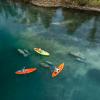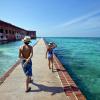As the sun rises over the Mosquito Lagoon, spotted sea trout run for cover as a solitary sea kayak slides across the water.
The sportfish find the lush sea grass to their liking. There's plenty of bait fish to fill their bellies and shallow flats provide protection from marauding dolphin. But on this balmy summer morning, there are other predators to worry about.
A bald eagle, circling about 500 feet above, drops in the blink of an eye and grabs the trout in its talons. The dramatic avian show is a treat indeed, but birders who frequent the Lagoon and nearby Indian and Banana rivers are accustomed to such spectacles.
The Indian River Lagoon System, heralded as America's most diverse estuary, boasts more than 4,000 different species of birds, plants and animals. Merritt Island National Wildlife Refuge and the adjacent Canaveral National Seashore offer unique public access to this national treasure with endless opportunities for bird watching and nature observation.
The Littoral Zone
With more than 24 miles of undeveloped oceanfront, Canaveral National Seashore's littoral zone (Apollo, Klondike and Playalinda beaches) is home to 14 endangered species. The primitive stretch of shoreline between Apollo and Playalinda is accessible only by foot and provides a unique chance to see how Florida's coastline looked before the arrival of hotels and condominiums.
Visitors who make the trek in the early morning may get a glimpse of one of three endangered species of sea turtle that lay their eggs on Canaveral's beaches each summer. In 2002, scientists counted 3,158 loggerhead, 859 green and eight leatherback sea turtle nests. From time to time, rare Kemp's Ridley and hawksbill are also spotted in the National Seashore's waters.
The turtle nesting season runs from late April through early September. The National Park Service offers "turtle tours" at night during the peak summer months, but they book up quickly, so plan well in advance.
The Seashore's beaches, located along a major north-south flyway, is a great place for a birder to add to their "life list." Scan the surfline for willet, ruddy turnstones, sanderling and the rare piping plover. If the wind is blowing hard out of the northeast, keep an eye out over open water for Northern gannet, boobies, shearwaters and storm petrel.
The Estuary
The Mosquito Lagoon, located on the leeward side of the barrier Island, averages about a mile wide and connects to the Atlantic Ocean at Ponce de Leon Inlet ten miles north of the park and drains through Haulover Canal into the Indian River which flows south to Jupiter Inlet.
The lagoon averages about four feet in depth, but the mud flats, oyster bars and lush sea grass beds provide excellent forage areas for a variety of rare and endangered birdlife.
Birders will note a variety of shorebirds, some migrating, others hunkering down for the winter months, feeding along the mud flats. Thousands of migrating ducks also stop at the fertile waters of the lagoon on their flyway south each year. Armed with a camera, birders will find ample opportunity to snap photos of waterfowl.
Beginning bird watchers can finish "Wader 101" in just one day as a variety of heron and egret also call the sheltered seashore waters home. Canaveral is also one of only two spots in Florida where the reddish egret is known to breed. Another rare species, the endangered wood stork, comes to feed when the fry, or tiny minnows, first hatch.
The Lagoon is also home to another endangered species, the West Indian Manatee. The large "sea cows" are more likely seen along the park's western boundary, where they use the Intracoastal Waterway as route south and north. Manatees leave the estuary during the winter months, but wildlife watchers may spot one at the Haulover Canal manatee overlook on Route 3.
For a firsthand look at all the area has to offer wildlife lovers, check out the annual Space Coast Birding & Wildlife Festival.
Other birds you might spots while in the area include:
- Wading birds: blue heron, tri-colored heron, snowy egret and white ibis
- Shore birds: laughing gull, willet, sanderling, turnstone, royal tern, cormorant, brown pelican and ring billed gull
- Flying birds: osprey, turkey vulture, pie-billed grebe and the common moorhen
PLACES TO REMEMBER
RELATED CONTENT
Great Hiking Trails in Florida
- 10 minute read
By Lauren Tjaden With varied terrain and tremendous ecological diversity, Florida provides hikers of every skill level a perfect backdrop for exercise...
Where and How to Meet Dolphins in Florida
- 9 minute read
Except perhaps for alligators, few animals are associated more with Florida than the dolphin. Here's where to see, feed, touch, paint with,...
























